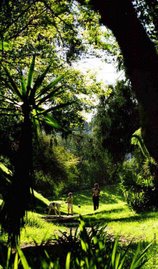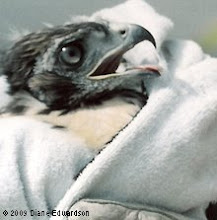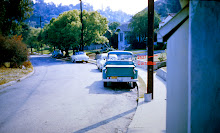The north end of the Red Car Property's California Black Walnut Trees were super lush. Take note of the large tree on the right. The chain link fence is directly across from the Adelbert cut-through. (Click on photos to enlarge.)
Fall of 2000 was the fire season prior to the City enacting strict brush clearance regulations for our hillsides. Trees and slopes were never cleared to the standards now required by LAFD. California Black Walnuts were not yet protected native trees.
 Photo: Diane Edwardson, July 4, 2010. Ten years later and now the City protected California Black Walnut Trees flourished on the north end of the property. The tall trees and steep slopes kept the north end of the property cooler and more moist, months longer than the rest of the Red Car Property.
Photo: Diane Edwardson, July 4, 2010. Ten years later and now the City protected California Black Walnut Trees flourished on the north end of the property. The tall trees and steep slopes kept the north end of the property cooler and more moist, months longer than the rest of the Red Car Property. More than 37" of rain officially fell in Los Angeles in the rain year 2004-2005. The ensuing below-average years (including a record low of 3.21" in 2006-2007) did not adversely affect the native trees which have very deep root systems as they evolved with our drought to El Nino conditions. 2009-2010 Rainfall was just above average in the City.
Photo: Diane Edwardson, June 18, 2011. Rain year 2010-2011 the official rainfall was over 20" for the City. We usually get about a third more than the official rainfall total due to the topographical features and weather patterns creating orographic lift on the way toward the San Gabriel and Verdugo Mountains. (Official rainfall for Los Angeles is measured at USC - south of downtown.)
Photo: Diane Edwardson, October 4, 2014. By October, the Black Walnuts were already dropping their leaves for fall (as opposed to the very first photo where they were still green in November). Take note of the dates here because the next shot is scary.
Photo: Diane Edwardson, July 27, 2015. The California Black Walnut tree on the right has fewer leaves now than it did in October 2014 (the previous photo). It's not only dropping leaves, but branches too. In April and May of this year it was healthy looking and green. We've also had record heat this year and 4 years of megadrought.
While digging through my archives, I discovered I had taken this tree for granted for so long, because it had been so healthy. I have winter and spring shots from different angles, but few matching summer shots in the last 3 years. Yet, it wasn't until May of this year that this tree started showing ill effects of the drought.
Don't rush out and cut down your native trees yet! It's not dead. And we will take a closer look tomorrow.
City of Los Angeles: Protected Native Tree Ordinance
City of Los Angeles: Dept of Urban Forestry
California Drought Monitor Map






